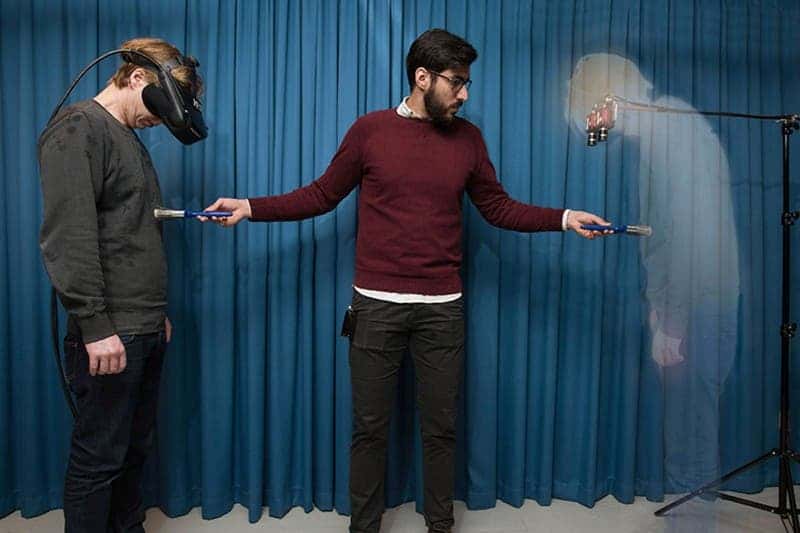
Two brushes were used to stroke a human and his invisible self at the same time. Credit: Karolinska Institute
What would you if you had the power of invisibility? Would you spy on friends to see what they say behind your back? Or worse, like the myth of the Ring of Gyges, would you use this ability to gain riches and ultimate power? Fantasy or morals aside, it is possible to become invisible — not in this reality, but in a virtual one. The sensation of invisibility can be very real, though, as Swedish researchers at the Karolinska Institute in Stockholm demonstrated.
In 2008, Henrik Ehrsson‘s used high-tech equipment to reenacted a famous psychological experiment called the “rubber hand experiment.” In the original experiment, a fake rubber hand positioned against the body of volunteers was stroked at the same time with one of the participants’ real hand. This sensorial input confused the brains of the volunteers and gave the illusion that the fake hand was as real as it gets.
What Ehrsson and colleagues did was use a mannequin with digital cameras for eyes which were pointed towards the mannequin’s plastic abdomen. A human volunteer wore a pair of VR goggles which essentially gave him the mannequin’s point of view. Two brushes were then used to simultaneously stroke both the human and mannequin. After a while, the human would report that the mannequin’s body felt like his own.
Eight years later, the same team pushed this a step forward. Instead of a mannequin, the researchers simply pointed the camera on a region of an empty then played the video feed into a human’s VR goggles. Then, very carefully one brush stroked the human and the other stroked … empty space. Remarkably, the same illusion of an outer body experience was experienced by 75 percent of the 20 volunteers involved in this experiment. Among them, members of the research team as well.
“I am very susceptible to illusions, so for me it worked,” says Arvid Guterstam, one of Ehrsson’s colleagues. “You have a vivid sensation of having a body, but it’s not directly visible. I don’t know what it would feel like to have a phantom body, but I imagine that’s what it’d feel like.”
“Most were surprised, and some started giggling. It’s a very unnatural, unexpected experience,” Guterstam added. “It’s the first time that anyone has shown that you can embody a full invisible body.”
Next came the most interesting part of this most amazing study. Those volunteers who had managed to effectively enter the invisibility state of illusion were asked to look up. Here, their gaze met a bunch of people with very serious countenances who were looking down at the volunteer quite disapprovingly. The same group of menacing people were shown in the VR feed of volunteers who were engaged in the mannequin illusion but did not feel invisible.
After they had measured things like heart rate, sweaty skin and other markers for anxiety, researchers concluded people felt less anxious in the invisibility illusion than in the mannequin dream.
“If you are truly experiencing a non-physical body, it should also be represented in the brain as invisible to outside observers,” says Guterstam. “So, the others’ gaze should not fall upon your physical body but on the illusory body.”
The findings published in Scientific Reports suggest that this sort of virtual reality settings might help a lot of patients battling their inner demons, like various phobias. More strikingly, the findings also clearly show that the mind-body link is far more fragile than some of us think.
Next, the Swedish researchers plan on doing brains scans once the invisibility illusion kicks in to see what goes on inside the brain.









